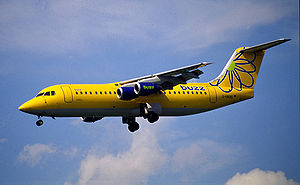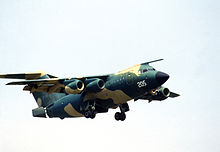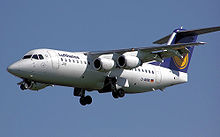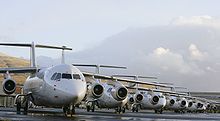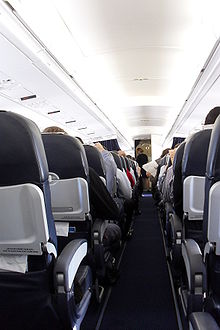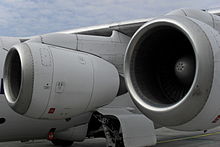- British Aerospace 146
-
BAe 146 / Avro RJ Buzz BAe 146-300 Role Airliner First flight 3 September 1981 Introduction May 1983 Status Active service Primary users Brussels Airlines
CityJet
Lufthansa CityLine
Swiss Air LinesProduced 1978-2001 Number built 387 (Avro RJ: 166; BAe 146: 221) The British Aerospace 146 (also BAe 146) is a medium-sized commercial airliner formerly manufactured in the United Kingdom by British Aerospace, later part of BAE Systems. Production ran from 1983 until 2002. Manufacture of an improved version known as the Avro RJ began in 1992. A further-improved version with new engines, the Avro RJX, was announced in 1997, but only two prototypes and one production aircraft were built before production ceased in late 2001. With 387 aircraft produced, the Avro RJ/BAe 146 is the most successful British civil jet programme.[1][2]
The BAe 146/Avro RJ is a high-wing cantilever monoplane with a T-tail. It has four turbofan engines mounted on pylons underneath the wings, and has retractable tricycle landing gear. The aircraft has very quiet operation, and has been marketed under the name Whisperjet. It sees wide usage at small city-based airports. In its primary role it serves as a regional jet, short-haul airliner or regional airliner. The BAe 146/Avro RJ is in wide use among European airlines, such as Brussels Airlines, CityJet, Swiss International Air Lines and Lufthansa. The freight-carrying version has the designation "QT" (Quiet Trader), while a convertible version is designated "QC".
The BAe 146 comes in -100, -200 and -300 models. The equivalent Avro RJ versions are designated RJ70, RJ85, and RJ100.
Contents
Development
Hawker Siddeley carried out the original design in 1973 using the designation HS.146, but soon abandoned the project as a result of the world economic downturn resulting from the 1973 oil crisis. Low-key development proceeded, however, and in 1978 British Aerospace, Hawker Siddeley's corporate successor, re-launched the project. The 146 type number comes from the original de Havilland designation sequence, which was continued by Hawker Siddeley when the former became a subsidiary of the latter. The type name "Avro RJ" superseded "BAe 146" in 1993.
 British Airways RJ100
British Airways RJ100
The BAe 146 received its Certificate of Airworthiness on 8 February 1983.[3]
Production
The early aircraft were built at what was originally a de Havilland factory at Hatfield. The Avro RJ family of aircraft was assembled at the BAE Systems Regional Aircraft Centre at the Avro Airfield at Woodford in Greater Manchester, England. Production of various sections of the aircraft was carried out at different BAE plants. The rear fuselage section was manufactured at BAE Systems' former Avro site at Chadderton, near Oldham, Greater Manchester. The center fuselage section was manufactured at the Filton BAE site. The fin came from Brough and the engine pylons were made at Prestwick.[4] The nose section was manufactured at Hatfield, where the assembly line for the early aircraft was located. Some manufacturing was subcontracted outside the UK. The wings were made by Textron in the USA and the tailplane and control surfaces were made by Saab-Scania in Sweden.[5] The original Lycoming ALF 502 geared turbofan engines were replaced by the higher thrust, derivative Honeywell LF 507 geared turbofan engines with the development of the Avro RJ series, which were housed in redesigned nacelles. The Avro RJ series also had a slightly modernised cockpit.[6] Production of this aircraft has ended, with the final four aircraft being delivered in October–November 2003. 166 Avro RJ aircraft were delivered between 1993 and 2002.
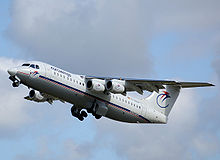 Eurowings BAe 146-300 in 2008
Eurowings BAe 146-300 in 2008
The aircraft have proven to be useful on "high density" regional and short-haul routes. In economy class, the aircraft can either be configured in a standard five-abreast layout or a high-density 6-abreast layout, making it one of very few regional jets that can use a 6-abreast layout in economy class. The plane is also renowned for its relatively quiet operation, a positive feature which won the hearts of many operators who wanted to fly in and out of noise stringent airports within cities. The aircraft is one of only a few types that can be used on flights to London City Airport, which has a unique steep approach and a short runway.[6]
Problems
The ALF 502 turbofans suffered from some reliability problems. The internal electronics were prone to overheating, which could trigger an automatic shutdown of an engine with no option of in-flight restarting, and certain rare atmospheric conditions caused loss of engine thrust due to internal icing.[7]
The BAe 146 experienced aerotoxic syndrome due to leakage of tricresyl phosphate (TCP) into the plane's bleed air. This has been blamed on problems with leaking engine seals.[8] Neurotoxic fumes have been known to incapacitate pilots.
Variants
 BAe 146 CC.2 (BAe 146-100 Statesman) of The Royal Squadron
BAe 146 CC.2 (BAe 146-100 Statesman) of The Royal Squadron
 Lufthansa Avro RJ85
Lufthansa Avro RJ85
 Atlantic Airways BAe 146-200
Atlantic Airways BAe 146-200
 Flybe BAe 146-300 series wearing the colours of an Internet gambling Company. Glasgow International Airport. July 2006.
Flybe BAe 146-300 series wearing the colours of an Internet gambling Company. Glasgow International Airport. July 2006.
BAe 146-100, Avro RJ70 & BAe 146 Statesman
First flight of the -100 occurred on 3 September 1981, with deliveries commencing in 1983.[9] The launch customer in March 1983 was Dan-Air, soon followed by the RAF's Royal Flight. The -100 was the last of the 146 series designs to be developed into the Avro RJ standard with first deliveries of the Avro RJ70 in late 1993. The RJ70 differed from the 146-100 in having FADEC LF 507 engines and digital avionics. The RJ70 seats 70 passengers five abreast, 82 six abreast or 94 in high-density configuration. The 146 is the first jet aircraft operated by the British Queen's Flight (later 32 (The Royal) Squadron), and entered service in 1986 after two aircraft were leased by the Royal Air Force for evaluation. The Queen's Flight acquired a total of three 146s, all fitted out with a luxurious bespoke interior. A complete spare interior was also ordered and held in storage at RAF Stafford. The aircraft are operated in a VIP configuration with a capacity of 19 passengers and 6 crew. The BAe 146-100QC is the convertible passenger/freight version and the BAe 146-100QT (Quiet Trader) is the freighter version.
BAe 146-200 and Avro RJ85
The 146-200 features a 2.41 m (7 ft 11 in) fuselage extension and reduced cost per seat mile. The -200 first flew in August 1982 and entered service six months later. The RJ85, the first RJ development of the BAe 146 family, features an improved cabin and the more efficient LF 507 engines. Deliveries of the RJ85 began in April 1993. The RJ85 seats up to 112 passengers. The BAe 146-200QC is the convertible passenger/freight version and the BAe 146-200QT (Quiet Trader) is the freighter version.
BAe 146-300 and Avro RJ100
Designers' initial proposals for the -300, the final development of the 146 product line, included a 3.2 m extension to the fuselage of the -200, more powerful engines and winglets. However due to the requirements of airlines for higher efficiency rather than capacity the production 146-300 emerged as a 2.44 m stretch of the -200, without winglets or the proposed ALF 502R-7. Deliveries began in December 1988. The Avro version of the 146-300, the second such development of the 146 product line, became the RJ100. It shared the fuselage of the 146 version, but with interior, engine and avionics improvements. The most common configuration in the RJ100 seats 100 passengers. The RJ115 seats 116 as standard or up to a maximum of 128 in a high-density layout. A modified version 146-301 is used as a Facility for Airborne Atmospheric Measurements (FAAM). The BAe 146-300QC is the convertible passenger/freight version and the BAe 146-300QT (Quiet Trader) is the freighter version.
BAe 146STA
Throughout the production life of the BAe 146, British Aerospace proposed a number of specialist military versions, including side and rear loading transports, an airborne tanker version,[10] and a carrier onboard delivery version.[11]
Of these proposals, only one, the BAe 146STA (Sideloading Tactical Airlifter), based on the BAe 146QT cargo aircraft, and with the same cargo door on the left side of the rear fuselage was built. The military transport version has a refuelling probe protruding from the nose. A demonstrator, fitted with a dummy refuelling probe and an air-openable paratroop door was displayed at the 1989 Paris Air Show and carried out extensive demonstration tours, but no orders resulted.[12]
BAe 146M
In 2009, BAE Systems announced the BAe 146M programme. This aims to sell ex-civilian BAe 146-200 and -300 aircraft to military air arms in either passenger or freighter configuration.[13]
Avro RJX series
The RJX-70, RJX-85 and RJX-100 aircraft represented advanced variants of the Avro RJ Series. The RJX series used Honeywell AS977[citation needed] turbofans for greater efficiency (15% less fuel-burn, 17% increased range), quieter performance and 20% lower maintenance costs. Drukair of Bhutan placed orders for two RJX-85s, while British European placed firm orders for 12 RJX-100s and 8 options.[14][dead link] However, BAE Systems terminated the project in December 2001, having completed and flown only three aircraft - a prototype each of the RJX-85 and RJX-100, and a production RJX-100 for British European. BAE reached an agreement with Druk Air and British European in early 2002 in which the airlines agreed not to enforce their firm orders for the RJX. BAE explored the possibility of manufacturing 14 "hybrid" aircraft, however British European at least was unwilling to accept the risk of operating a unique type.[15]
The termination of the RJX project marked the end of complete commercial airliner production in the United Kingdom, though various components for Airbus aircraft continue to be produced there.
Operators
Main article: List of BAe 146 operatorsCivilian operators
Cabin of a CityJet Avro RJ85
- BAe 146
As of August 2008, a total of 140 BAE 146 aircraft (all variants) remain in airline service.[16] Major operators include:
- Albanian Airlines (3)
- Belle Air (1)
- TNT Airways (16)
- TAM (4)
- Air Botswana (1)[17]
- TABA (2)
- Bulgaria Air (8)
- North Cariboo Air (1)
- Tronos (20)
- Aerovías DAP (1)
- WDL Aviation (5)
- Astra Airlines (2)
- Starbow Airlines (2)
- MDLR Airlines (3)
- Aviastar Mandiri
- Penas Air
- Riau Airlines (2)
- CityJet (12)
- Nex Aviation (1)
- Heritage Air [18]
- efly (1)
- Vincent Aviation (1)
- Air National - Former operator, ceased flight operations in 2010.
- Ansett New Zealand - Former operator, ceased operations in 2001.
- Mount Cook Airlines - Former operator.
- Líneas Aéreas Paraguayas (1 BAe 146-300)
- Regional Paraguaya (1 BAe 146-200)
- Asian Spirit (4)
- Airlink (4)
- Directflight (operated on behalf of the Facility for Airborne Atmospheric Measurements) (1).
Some 17 other airlines also operate smaller numbers of the type.[20]
- Avro RJ
As of August 2006, a total of 152 Avro RJ aircraft (all variants) also remain in airline service. Major operators include:
- Brussels Airlines (25)
- Bulgaria Air (1)
- Atlantic Airways (4)
- Lufthansa CityLine (18)
- Aegean Airlines (6)
- MDLR Airlines (2)
- CityJet (23)
- Eznis Airways (2)
- Airlink (1)
- Malmö Aviation (12)
- Transwede Airways (6)
Some 12 other airlines also operate smaller numbers of the type.[20]
Military operators
- Bolivian Air Force[21]
- Free Libyan Air Force
Notable incidents
The BAe-146/Avro RJ has been involved in seven hull-loss accidents with a total of 259 fatalities.[22][23]
- On 7 December 1987, a Pacific Southwest Airlines Flight 1771 BAe 146-200 (registration N350PS) crashed after a disgruntled former USAir employee aimed a .44 Magnum pistol and fired several shots in or near the cockpit area, causing the aircraft to enter a steep nosedive. All of the 43 passengers and crew members on board were killed. At the time airline employees were allowed to bypass security checkpoints.[24]
- On 20 February 1991, a chartered LAN Chile BAe 146-200A (registration CC-CET) overran runway 8 while landing at Puerto Williams Airport (WPU), Chile, killing 20 of the 73 people on board.[25]
- On 22 March 1992, an Ansett Airlines BAe 146-200A (registration VH-JJP) experienced a failure of all four engines (a condition known as an uncommanded rollback) and the electrical system at night while en-route from Karratha to Perth, Western Australia at 31,000 feet in icing conditions. The aircraft landed safely at Meekatharra following restart of the engines at lower altitude.[26]
- On 23 July 1993, a China Northwest Flight 2119 BAe 146-300 (registration B-2716) crashed while attempting to take off from Yinchuan Airport (INC), People's Republic of China. 55 of the 113 passengers and crew were killed.[27]
- On 25 September 1998, a PauknAir Flight 4101 BAe 146-100 (registration EC-GEO) crashed while on an approach to runway 15 at Melilla Airport (MLN/GEML), Spain. All of the 38 passengers and crew were killed.[28]
- On 24 November 2001, Crossair Flight 3597 Avro RJ-100 (registration HB-IXM) crashed while on a VOR/DME approach to runway 28 at Zürich-Kloten Airport (ZRH/LSZH), Switzerland. 24 of the 33 passengers and crew were killed.[29]
- On 8 January 2003, Turkish Airlines Flight 634, an Avro RJ-100 (registration TC-THG) crashed while on a VOR/DME approach to runway 34 at Diyarbakir Airport (DIY/LTCC), Turkey. 75 of the 80 passengers and crew were killed.[30]
- On 10 October 2006, a Atlantic Airways Flight 670 BAe 146-200A (registration OY-CRG) skidded off the runway while landing at Stord Airport, Norway. The spoilers did not deploy when the aircraft landed. 3 passengers and 1 crew member were killed, of the 16 persons on board.[31][32]
- On 13 February 2009, a BA CityFlyer Flight 8456 Avro RJ-100 (Registration G-BXAR) suffered a nosewheel collapse whilst landing at London City Airport. Four minor injuries were reported.[33]
- On 9 April 2009, a BAe 146-300 belonging to Aviastar Mandiri, an Indonesian charter operator, crashed into the side of Pike Mountain, Wamena and burst into flames killing all six crew after being ordered by the air traffic controller to abort the initial landing attempt.[34]
- On 10 November 2011, an SA Airlink Avro RJ85 made a emergency landing at OR Tambo International Airport in Johannesburg, South Africa. Shortly after take-off the crew realised there was a problem with the nose wheel. The plane landed with the gear retracted and skidded to a halt. All 73 passengers and four crew survived. [35]
Specifications (BAe 146-200)
Data from Jane's All The World's Aircraft 1993-94[36]
General characteristics
- Crew: 2 pilots and 2 or 3 flight attendants
- Capacity: 82–112 passengers
- Length: 93 ft 10 in (28.60 m)
- Wingspan: 86 ft 0 in (26.21 m)
- Height: 28 ft 2 in (8.59 m)
- Wing area: 832.0 ft² (77.30 m²)
- Empty weight: 52,684 lb (23,897 kg)
- Max takeoff weight: 93,000 lb (42,184 kg)
- Powerplant: 4 × Textron Lycoming ALF 502R-5 turbofans, 6,970 lbf (31.0 kN) each
Performance
- Cruise speed: 498 mph (432 knots, 801 km/h) at 29,000 ft (8,840 m) (high speed cruise)
- Range: 1,808 mi (1,570 nmi, 2,909 km) (Standard fuel)
See also
- Aircraft of comparable role, configuration and era
- Related lists
- List of airliners
- List of BAe 146 operators
References
- ^ Frawley, p. 72
- ^ Avro RJ
- ^ Donne, Michael (9 February 1983). "BAe 146 cleared for delivery to airlines". Financial Times (The Financial Times Limited): p. 21.
- ^ Piggot, Peter (2005). Royal transport: an inside look at the history of royal travel.
- ^ "History of the BAe 146". The BAe 146. http://www.shockcone.co.uk/bae146/hist3.htm. Retrieved 2011-03-17.
- ^ a b VLM Introduces Jet Aircraft, Velocity, VLM Magazine, May 2007. Retrieved 2 January 2008.
- ^ http://www.highbeam.com/library/docfree.asp?DOCID=1G1:62527181&ctrlInfo=Round19%3AMode19a%3ADocG%3AResult&ao
- ^ Barnett, Antony (26 February 2006). "Toxic cockpit fumes that bring danger to the skies". The Guardian (London). http://www.guardian.co.uk/business/2006/feb/26/theairlineindustry.uknews.
- ^ Taylor, John W R (1988). Janes All the World's Aircraft 1988-89. Coulsdon, Surrey, UK: Jane's. p. 284. ISBN 0 7106-0867-5.
- ^ Skinner 2005, p.21.
- ^ Skinner 2005, p.22.
- ^ Skinner 2005, pp. 22–24.
- ^ "BAE Systems Seeks Military Air Transport Customers For BAe 146M". www.baesystems.com. BAE Systems. 8 September 2009. http://www.baesystems.com/Newsroom/NewsReleases/autoGen_10988101746.html. Retrieved 10 September 2009.
- ^ BRITISH EUROPEAN CONFIRMS ORDER FOR 20 AVRO RJX-100 AIRLINERS AND SELECTS JETSPARES & EFDMS, BAE Systems. Retrieved 1 January 2008.[dead link]
- ^ Vines, Mike (March 2002). "RJX Dead and Buried". Business & Commercial Aviation (The McGraw-Hill Companies, Inc.): p. 32.
- ^ "BAe146 summary". http://www.aerospace-technology.com/projects/bae146/.
- ^ [1]
- ^ [2]
- ^ Star Peru buys 2 new BAe 146
- ^ a b Flight International, 3–9 October 2006
- ^ "BAe 146 Family industry data" (PDF). Aircraft Technology Engineering & Maintenance magazine Paris Special. 18 June 2007. http://www.aviationindustrygroup.com/index.cfm?format=1718. Retrieved 16 July 2007.
- ^ Aviation Safety Network - BAe 146
- ^ "Have taken 216 human lifes (Norwegian language)". Bergens Tidende. 11 October 2006. http://www.bt.no/lokalt/hordaland/article305103.ece. Retrieved 16 July 2007.
- ^ Aviation Safety Network report - 7 December 1987 crash
- ^ Aviation Safety Network report - 20 February 1991 crash
- ^ Australian Bureau of Air Safety Report B/925/3042
- ^ Aviation Safety Network report - 23 July 1993 crash
- ^ Aviation Safety Network report – 25 September 1998
- ^ Aviation Safety Network report - 24 November 2001 crash
- ^ Aviation Safety Network report - 8 January 2003 crash
- ^ Norway runway blaze kills three, BBC News, 10 October 2006.
- ^ Aviation Safety Network report - 10 October 2006 crash
- ^ BA plane's undercarriage fails on landing, 4 hurt, Reuters UK, 13 February 2009.
- ^ "Six Dead After Cargo Plane Crashes in Papua’s Mountains" Jakarta Globe Retrieved on 09-04-2009
- ^ [3] News 24 Retrieved 11-11-2011
- ^ Lambert 1993, pp. 383–385.
- Frawley, Gerard (2003). The International Directory of Civil Aircraft, 2003-2004. Fyshwick, ACT, Australia: Aerospace Publications Pty Ltd. ISBN 1-875671-58-7.
- Lambert, Mark (editor) (1993). Jane's All The World's Aircraft 1993-94. Coulsdon, UK: Jane's Data Division. ISBN 0 7106 1066 1.
- Skinner, Stephen (2005). "Lost Opportunities: Military Versions of the BAe 146". Air Enthusiast (Stamford, UK: Key Publishing) (120, November/December 2005): pp. 20–24. ISSN 0143 5450.
- Taylor, John W.R. (editor) (1988). Jane's All The World's Aircraft 1988-89. Coulsdon, UK: Jane's Defence Data. ISBN 0 7106-0867-5.
External links
- Manufacturer website – BAe 146 – Avro RJ
- Smiliner 146 family information page
- Aerospace-Technology – Avro RJ – Avro RJX
- (German) "Jumbolino-Flug abgebrochen"
- THE BAE 146 at Greg Goebel's AIR VECTORS
- Airliners net British Aerospace BAe 146
British Aerospace and BAE Systems aircraft Combat aircraft Harrier • Harrier II • Jaguar • Sea Harrier • Tornado • Tornado ADV • Typhoon
Patrol and surveillance Nimrod • Nimrod AEW3 • Nimrod MRA4
Trainers Airliners/Transports ATP • BAe 125 • BAe 146 • Concorde • Jetstream 31/32 • Jetstream 41 • Jetstream 61 • One-Eleven
Drones (UAVs) Combat drones (UCAVs) Fury • Taranis
Development/Concept aircraft Lists relating to aviation General Aircraft (manufacturers) · Aircraft engines (manufacturers) · Airlines (defunct) · Airports · Civil authorities · Museums · Registration prefixes · Rotorcraft (manufacturers) · TimelineMilitary Accidents/incidents Records Categories:- British airliners 1980–1989
- British Aerospace aircraft
- Quadjets
Wikimedia Foundation. 2010.

